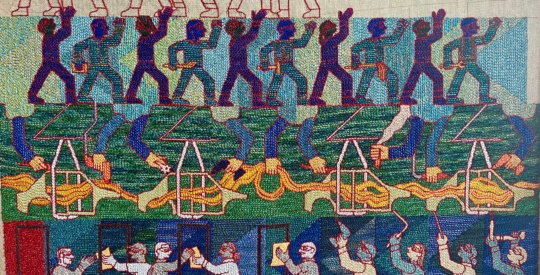[cont.]
“He’s still a New Yorker, even if he’s based here. And you’ve filled the show with New Yorkers. They have plenty of opportunities in New York. Why are you showing them here? Everyone knows that LA artists are doing much more interesting work than New Yorkers. If you were smart, all of that space would go to our artists.”
“Art is a dialogue, Kay. If you only talk to the same people, you only hear a certain set of opinions. I’ve made a point of including artists from Chicago, Philadelphia, Dallas and San Francisco as well. Opening that dialogue up to others is good for artists and good for the arts community.”
“You’re supposed to nurture local artists. If you don’t, what good are you?”
Odessa sighed and walked away exasperated. This was the first time she’d even seen Kay in the gallery and she had definitely never signed the visitor log book. Support goes both ways. What were the schools teaching their students? What Kay and that demanding young man apparently expected was for the commercial art world to act as an extension of the fairyland of school where teachers were paid to care about each little mark their students made and coo encouragement. Galleries were businesses: her job was to sell work and develop the careers of the artists she selected, not nurture every artist who wandered in off the street.
Unfortunately, Kay’s xenophobia was not atypical. LA was a strange, fragmented art scene, fueled and energized almost exclusively by the influx of students to its fine schools. Quite a few locals would agree with Kay that the art scene existed primarily to promote the students. Beyond the schools, art was seriously underfunded. LA ranked 41st nationwide in charitable giving, behind Minneapolis and Detroit. Its history of patronage was not deep or long. The city didn’t even have major art museums until LACMA opened in 1965 and MOCA in the early 1980s and MOCA remains so underfunded it’s nothing short of a miracle it has managed to stay open. LA could boast one major donor and he tried his level best to control everything he touched. His taste was pretty limited to shiny bombastic things which he tended to purchase from a single gallery in New York. The rest of the arts organizations still functioned like a small town operation. The city gave out limited grants to artists but these were divided among the districts. Talent was less important than treating the districts equally.
Whenever she started grousing about LA, sounding all preachy, she knew her blood sugar levels had dropped. LA was such an easy target for dissatisfaction. Sometimes it just felt like such a raving stereotype and other times it was fabulous, so much more open and adventurous than status conscious New York could ever be. As she pulled out a case of wine, she told herself to stop being so angry with Kay and her lack of grace. Kay’s resentment stemmed from insecurity and Odessa knew that condemning insecurity anywhere in the art world was like becoming indignant about farts after a constant diet of beans and broccoli. It’s just part of the nature of things.
Once she showed the intern how to use the fancy corkscrew and watched Maggie chatting up a critic, she retreated into her office to chew on a protein bar for that bit of sugar she needed to sweeten her disposition.
With the first bite still in her mouth, Paula barged in, slightly red faced. “Odessa, why didn’t you include Kay in this show? I recommended her.”
Odessa swallowed. “I did a studio visit with her and talked with you afterwards. Don’t you remember? I remember telling you straight out that I didn’t respond to the work.”
“And then I told you about her divorce. I can’t believe you have no sympathy for her.”
“What does sympathy have to do with showing someone’s work?”
“She’s devastated.”
“I told you I didn’t respond to Kay’s work and I never said anything to you or to her to encourage her expectations. If you did, then as her friend, you should go comfort her.”
“I can’t believe you are so heartless. You say you are supportive of women in the arts and then you do this. You need to look long and hard at how you treat people.” She spit all that out and then she stormed away, fists clinched.
Odessa poured herself a glass of wine and continued munching on the protein bar. Seven of the eleven artists in the show were women. 66% of the artists she represented were women. Men might could complain but she had a great track record showing women artists. Odessa sighed. Embarrassment so often masks itself in this kind of righteous duck fit. She’d witnessed it often enough first hand. During her New York years, Odessa lived right at the corner of an intersection in Brooklyn Heights which desperately needed a stop light. She’d sit at her tiny kitchen table and watch the traffic as she ate. Over and over, she observed the same behavior after an accident. Those who screamed loudest were almost invariably the ones who failed to obey the stop sign. It’s human nature to deflect blame. As her daddy used to say, it’s a bankable response.
Just Like Suicide pt. 16
Related Stories
Daily
Reviews
Features
In the Studio with Chayse Sampy
Amarie Gipson visits mixed-media artist Chayse Sampy in her shared studio in Downtown Houston to discuss living in the South, Afro-surrealism, and the color blue.
A Landscaped Longed For: The Garden as Disturbance at the Crisp-Ellert Art Museum, St. Augustine
Christopher Stephen reviews the visual metaphors of the garden found in A Landscape Longed For: The Garden as Disturbance at the Crisp-Ellert Art Museum, St. Augustine.
Weaving Work: On the Tapestries of Tabitha Arnold
Lina Alam profiles the spiritual allegories and the labor of weaving works created by Chattanooga-based artist Tabitha Arnold.




